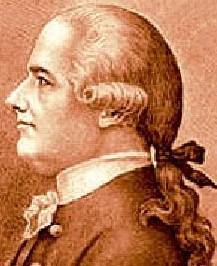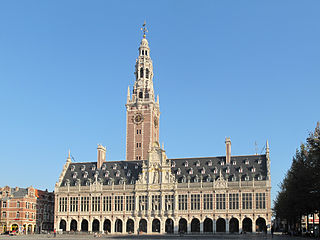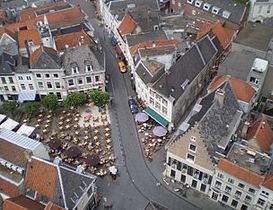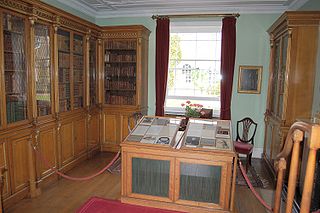Jan Ingenhousz
Biography
Famous Biologists
EUGENE M. MCCARTHY, PHD
 Ingenhousz
Ingenhousz Library, Univ. of Leuven
Library, Univ. of Leuven Breda today
Breda today
Jan Ingenhousz (1730-1799). Dutch-born physician, chemist, and plant physiologist. Showed light is essential to plant respiration and that the gas plants produce in light is oxygen. He is therefore recognized as the discoverer of photosynthesis.
Jan Ingenhousz was born in 1730 in the city of Breda in what is today the southern Netherlands. At 16, he began his study of medicine at the University of Leuven, the oldest and most prominent university in Belgium. There he received his MD in 1753. He then studied two additional years at the University of Leiden, where he attended lectures by Pieter van Musschenbroek, an experience that sparked his lifelong interest in electricity.
Returning home to Breda in 1755, he began his practice as a physician. He settled there until the year his father died (1764), but then decided to travel to England to learn the latest techniques in smallpox immunization. In this enterprise he was assisted by a family friend, Sir John Pringle, then President of the Royal Society. While in England, he became personally acquainted with such famous personalities as Benjamin Franklin, Henry Cavendish and Joseph Priestley.
Ingenhousz became a leading proponent of variolation, an early method used to immunize patients against smallpox (Variola) that involved inoculating patients with smallpox virus taken from patients with a mild form of the disease. During an epidemic in Hertfordshire in 1767, he successfully used this method to immunize 700 people against smallpox and, soon after, provided the same service to the family of King George III.
|
|
| Maria Theresa |
The following year, the Austro-Hungarian ruler, Maria Theresa, who had been scarred by smallpox, read about the success of the English campaign against the disease and decided to have her family treated, though her own doctors were against it. She wrote to George for his advice concerning the best physician and on his recommendation chose Ingenhousz, who traveled to Austria and successfully variolated her three youngest children. As a result, he became the personal physician both of Maria Theresa and of her son Joseph II. Ingenhousz lived the next ten years in Vienna, where in 1775 he married Agatha Maria Jacquin.
Jan Ingenhousz and the discovery of photosynthesis
In 1779, Ingenhousz returned to England and traveled to Calne, a small town in southwestern part of the country. There, at Bowood House, the country manor of the Marquis of Lansdowne, in the same laboratory where his colleague Joseph Priestley had discovered oxygen itself only a few years before, Ingenhousz carried out his research on photosynthesis.

|
|
The laboratory at Bowood |
| Actually, the Swedish chemist Carl Wilhelm Scheele (1742-1786) discovered oxygen before Priestly but didn't receive credit because Priestley published his findings first. |
|
|
|
Diagram of photosynthesis Credit: NASA Ames |
In the experiment leading to his discovery, he placed plants underwater in a transparent container and saw that the undersides of their leaves made bubbles in sunlight. However, when the same plants were placed in darkness, the bubbles eventually stopped forming. He was also able to see that the leaves and other green (chlorophyll-containing) parts of the plants were the sites where the gas was produced.
He collected this gas and conducted a series of tests to determine its identity. He eventually found that a smoldering candle would burst into flame when exposed to the unknown gas, which showed it was oxygen (Ingenhousz, 1779, see full citation below). He also found that in darkness plants release carbon dioxide (ibid).
Brownian motion
In 1785, Ingenhousz reported that under a microscope he had observed irregular movement of coal dust on the surface of alcohol. He thus described Brownian motion at a much earlier date than did Robert Brown (1827), the English investigator for whom the phenomenon is named.
Ingenhousz was taken ill during a visit to the Marquis at Bowood in 1799. He died there on September 7th and was buried nearby at Calne.
|
|
| Device Ingenhousz used to investigate photosynthesis |
Back to main biography page >>
Notes:
- Jan Ingenhousz also made a study of electricity and met with Benjamin Franklin and Henry Cavendish, the discoverer of hydrogen, to discuss the phenomenon.
- Priestley himself deserves some of the credit for the discovery of photosynthesis, as Ingenhousz (1779, p. xv) mentions Priestley's "important discovery, that plants wonderfully thrive in putrid air; and that the vegetation of a plant could correct air fouled by the burning of a candle, and restore it again to its former purity and fitness for supporting flame, and for the respiration of animals." Ingenhousz (ibid, p. xvi) also quotes from a speech delivered at the Royal Society in November 1773 by John Pringle, the Society's president, who said that from Priestley's "discoveries we are assured, that no vegetable grows in vain, but that, from the oak of the forest to the grass in the field, every individual plant is serviceable to mankind; if not always distinguished by some private virtue, yet making a part of the whole, which cleanses and purifies our atmosphere."
- Some basic facts about Jan Ingenhousz: Born December 8, 1730, Breda, Netherlands; died September 7, 1799, Calne, UK. Known for discovery of photosynthesis and his work with variolation.
- Pronunciation of Ingenhousz: /IN-jen-house/ (approximately rhyming with the English word house).
Work Cited:
Jan Ingenhousz, 1779. Experiments upon vegetables, discovering their great power of purifying the common air in the sun-shine, and of injuring it in the shade and at night. To which is joined, a new method of examining the accurate degree of salubrity of the atmosphere, London.